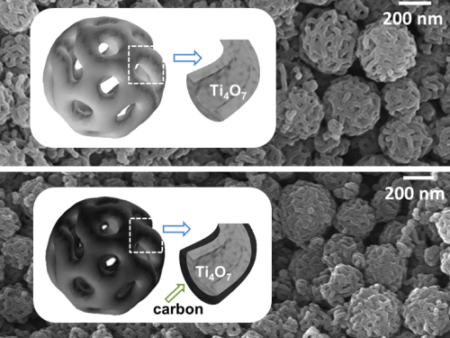May
18
Lithium Sulfur Batteries Get a New Cathode
May 18, 2017 | Leave a Comment
Helmholtz-Zentrum Berlin für Materialien und Energie scientists have fabricated a nanomaterial made from nanoparticles of a titanium oxide compound for lithium sulfur battery cathodes. The titanium oxide, Ti4O7 is characterized by an extremely large surface area, and was tested as a cathode material in lithium sulfur batteries.

The porous structure of the nanoparticles is visible under the electron microscope. Image Credit: HZB. Click image for the largest view.
Presently lithium batteries are one of the best solutions for storing electrical power in a small space. Lithium ions in these batteries migrate from the anode pole to the opposite electrical cathode pole during the discharge cycle. The anode and cathode generally consist of heavy-metal compounds that are expensive and toxic.
One interesting alternative is the lithium sulfur battery. A lithium sulfur cathode does not consist of heavy metals, but instead its sulfur, an economical and widely available material. As lithium ions migrate to the cathode during the discharge cycle, a reaction takes place there that forms lithium sulfide (Li2S) via various intermediate lithium polysulfides. During cycling, dissolution of lithium polysulfides causes the battery’s capacity to decline over the course of multiple charging cycles via the so-called “shuttle effect.” For this reason, researchers the world over are working to improve cathode materials that would be able to chemically or physically confine or encapsulate polysulfides, such as with nanoparticles made of titanium dioxide (TiO2), for example.
The scientific paper explaining the research has been published in Advanced Functional Materials.
The HZB team headed by Professor Yan Lu has now fabricated a cathode material that is even more effective. Here as well, nanoparticles provide confinement of the sulfur. However, they do not consist of titanium dioxide, but instead of Ti4O7 molecules arranged on a porous spherical surface. These porous nanoparticles bind polysulfides substantially more strongly than the usual TiO2 nanoparticles.
Yan Lu explained, “We have developed a special fabrication process to generate this complex, three-dimensionally interconnected pore structure.” Yan Lu first fabricates a template made of a matrix of tiny polymer spheres that have porous surfaces. This template is prepared in additional steps, then submerged in a solution of titanium isopropoxide. A layer of Ti4O7 is formed on the porous spheres and remains after thermal treatment, which decomposes the underlying polymer. Compared with other cathode materials made of titanium oxides, the Ti4O7 nanosphere matrix possesses an extremely large surface area. 12 grams of this material would cover a football field.
X-ray spectroscopy measurements (XPS) at the CISSY experiment of BESSY II show that sulfur compounds bind strongly to the surface in the nanomatrix.
This also accounts for the high specific capacity per gram (1219 mAh) at 0.1 C (1 C = 1675 mA g-1). The specific capacity also declines very little during repeated charge/discharge cycles (0.094 per cent per cycle). By comparison, the specific capacity of cathode materials made of TiO2 nanoparticles is 683 mAh/g. To increase the conductivity of this material, it is possible to apply a supplementary coating of carbon to the nanoparticles. The highly porous structure remains intact after this process.
Yan Lu said, “We have been working to improve the repeatability of this synthesis for over a year. Now we know how to do it. Next, we will work on fabricating the material as a thin-film.” And the best part: in this case, what has been successful in the laboratory can also be transferred to commercial manufacturing. This is because all the processes, from the colloid chemistry to the thin-film technology, are scalable.
Its a great month for lithium sulfur battery breakthroughs. Last week we saw an impressive innovation for the liquid electrolyte and now, the cathode. That fundamentally leaves the anode to go. And figuring out how to get these or other technologies together to offer the market a vastly superior battery at lower cost..

